![]()
At the Edge sub-object level, you can select single and multiple edges and transform them using standard methods. This topic covers the Edit Geometry and Edit Edges rollouts; for other controls, see Editable Poly.
Procedures
Example: To use the Cut and Turn features:
- In the Perspective viewport, create a Plane object. This object is available from the Create panel
 Geometry
Geometry  Standard Primitives
Standard Primitives  Object Type rollout.
Object Type rollout.
By default, the Plane object is divided into 4 x 4 polygons. If you don't see the polygons in the Perspective viewport, press F4 to activate Edged Faces view mode.
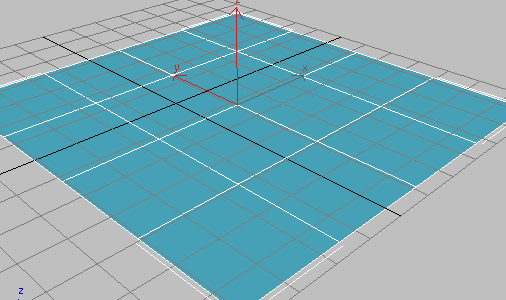
- Convert the Plane object to Editable Poly format. If you're not sure how, continue in this step; otherwise, skip to the next step after converting.
To convert the object, right-click once in the Perspective viewport to exit create mode. This leaves the object selected. Right-click again in the Perspective viewport, and then at the bottom of the Transform quadrant, choose Convert To
 Convert To Editable Poly. Alternatively, apply the Edit Poly modifier.
Convert To Editable Poly. Alternatively, apply the Edit Poly modifier.
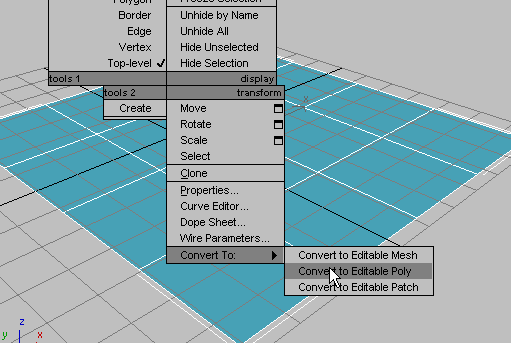
The object is now an editable poly and the command panel switches to the Modify panel.
- Cut is available at the object level as well as at every sub-object level. On the Edit Geometry rollout, find the Cut button, and then click it.
- In the Perspective viewport, position the mouse cursor in the center of a corner polygon, such as the one closest to you, click once, and then move the mouse around the viewport.

Two or three lines appear and move as you move the mouse. One line connects the mouse cursor to the original click location, and indicates where the next cut will appear when you click the mouse button. Another connects to a corner of the polygon; this connection changes depending on the mouse position. And, if the cursor isn't over an edge or a vertex (it changes appearance if it is, depending on which), a third line connects the mouse cursor to another vertex.
This demonstrates one aspect of the new Cut functionality; in previous versions, the first click in a Cut operation connected to two corners of the polygon.
- Continue cutting in a rectangular pattern, clicking once at the center of a different polygon, finish by clicking once more at the starting point, and then right-click to exit Cut mode.
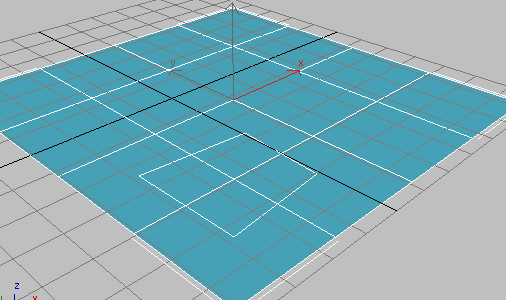
The result is a rectangle across four polygons, without any connecting visible edges. In previous versions, you would have had eight connecting visible edges: two in each of the original polygons. Note that all the edges you created are selected, and ready for further transformation or editing.
- Cut a rectangle into the center of a single polygon.
In this case you end up with a single, additional visible edge instead of seven, as in previous versions. The edge connects corner of the new polygon with a corner of the original one. This new edge is not selected, but the ones you created explicitly are.
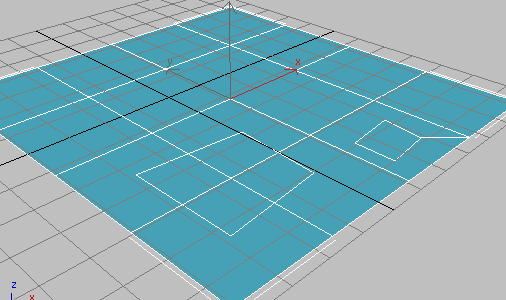
Connecting the remaining corners are a number of diagonals, which serve to fully triangulate the polygons. The new Turn function lets you manipulate each of these with a single click.
- Go to the Edge sub-object level, and then, on the Edit Edges rollout, click Turn.
All diagonals, including those created from the Cut operations, appear as dashed lines.
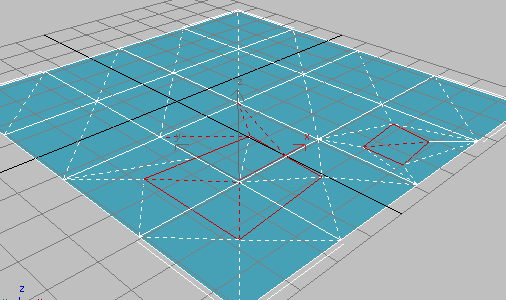
- Click a diagonal to turn it, and then click it again to return it to its original status.

In Turn mode, click a diagonal (dashed line) once to turn it.
Each diagonal has only two different available positions, given no changes in any other diagonals' or edges' positions.
Compare this with the Edit Triangulation tool, with which you must click two vertices to change a diagonal's position.
This simple demonstration shows how, when manually subdividing a polygon mesh for modeling and animation purposes, you can save a good deal of time by using the Cut and Turn tools in 3ds Max.
3ds Max provides a convenient function for turning edges, which, along with the Cut feature, streamlines the custom modeling process considerably. Specifically, cutting a new polygon into existing geometry minimizes the number of extra visible edges, typically adding none or one. And after using cut, the Turn function lets you adjust any diagonal with a single click.
To create a shape from one or more edges:
- Select the edges you want to make into shapes.
- On the Edit Edges rollout, click Create Shape From Selection.
- Make changes, as needed, on the Create Shape dialog that appears.
- Enter a curve name or keep the default.
- Choose Smooth or Linear as the shape type.
- Click OK.
The resulting shape consists of one or more splines whose vertices are coincident with the vertices in the selected edges. The Smooth option results in vertices using smooth values, while the Linear option results in linear splines with corner vertices.
If the selected edges are not continuous, or if they branch, the resulting shape will consist of more than one spline. When the Create Shape function runs into a branching 'Y' in the edges, it makes an arbitrary decision as to which edge produces which spline. If you need to control this, select only those edges that will result in a single spline, and perform a Create Shape operation repeatedly to make the correct number of shapes. Finally, use Attach in the Editable Spline to combine the shapes into one.

Above: Original object
Below: Object with edges selected
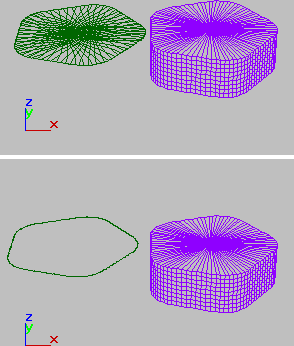
Above: Selected edges removed from original object
Below: Unwanted edges removed
Interface
This topic provides detailed information on the edge-specific rollout: Edit Edges. The remaining rollouts are described in their own topics.
Edit Edges rollout
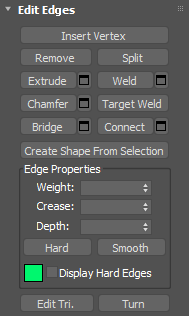
This rollout includes commands specific to edge editing.
- Insert Vertex
- Lets you subdivide visible edges manually.
After turning on Insert Vertex, click an edge to add a vertex at that location. You can continue subdividing polygons as long as the command is active.
To stop inserting edges, right-click in the viewport, or click Insert Vertex again to turn it off.
- Remove
- Deletes selected edges and combines the polygons that use them. Keyboard equivalent:
Backspace.
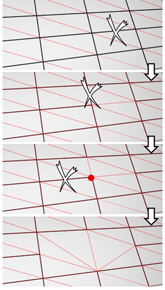
Removing one edge is like making it invisible. The mesh is affected only when all or all but one of the edges depending on one vertex are removed. At that point, the vertex itself is deleted and the surface is retriangulated.
To delete the associated vertices when you remove edges, press and hold down Ctrl while executing a Remove operation. This option, called Clean Remove, ensures that the remaining polygons are planar.

Left: The original edge selection
Center: Standard Remove operation leaves extra vertices.
Right: Clean Remove with Ctrl+Remove deletes the extra vertices.
Edges with the same polygon on both sides usually can't be removed.
Warning: Use of Remove can result in mesh shape changes and non-planar polygons. - Split
- Divides the mesh along the selected edges.
This does nothing when applied to a single edge in the middle of a mesh. The vertices at the end of affected edges must be separable in order for this option to work. For example, it would work on a single edge that intersects an existing border, since the border vertex can be split in two. Additionally, two adjacent edges could be split in the middle of a grid or sphere, since the shared vertex can be split.
- Extrude
- Lets you extrude edges manually via direct manipulation in the viewport. Click this button, and then drag vertically on any edge to extrude it.
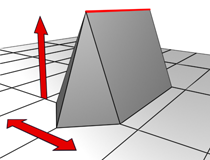
When extruding a vertex or edge interactively in the viewport, you set the extrusion height by moving the mouse vertically and the base width by moving the mouse horizontally.
Extruding an edge moves it along a normal and creates new polygons that form the sides of the extrusion, connecting the edge to the object. The extrusion has either three or four sides; three if the edge was on a border, or four if it was shared by two polygons. As you increase the length of the extrusion, the base increases in size, to the extent of the vertices adjacent to the extruded edge's endpoints.
Following are important aspects of edge extrusion:
- When over a selected edge, the mouse cursor changes to an Extrude cursor.
- Drag vertically to specify the extent of the extrusion, and horizontally to set the size of the base.
- With multiple edges selected, dragging on any one extrudes all selected edges equally.
- You can drag other edges in turn to extrude them while the Extrude button is active. Click Extrude again or right-click in the active viewport to end the operation.
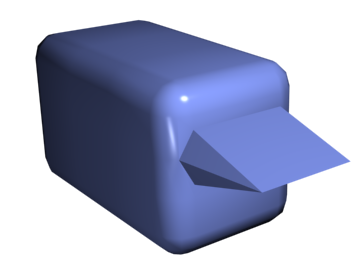
Chamfer box showing extruded edge
-
 Extrude Settings Opens the
Extrude Edges caddy, which lets you perform extrusion via interactive manipulation.
Extrude Settings Opens the
Extrude Edges caddy, which lets you perform extrusion via interactive manipulation.
If you click this button after performing a manual extrusion, the same extrusion is performed on the current selection as a preview and the caddy opens with Extrusion Height set to the amount of the last manual extrusion.
- Weld
- Combines selected edges that fall within the threshold specified on the
Weld caddy.
You can weld only edges that have one polygon attached; that is, edges on a border. Also, you cannot perform a weld operation that would result in illegal geometry (for example, an edge shared by more than two polygons). For example, you cannot weld opposite edges on the border of a box that has a side removed.
-
 Weld Settings Opens the
Weld Edges caddy, which lets you specify the weld threshold.
Weld Settings Opens the
Weld Edges caddy, which lets you specify the weld threshold.
-
- Chamfer
- An edge chamfer "chops off" the selected edges, creating two or more new edges for each chamfered edge. It also creates one or more polygons connecting the new edges. The new edges are exactly <chamfer amount> distance from the original edge. New chamfer polygons are created with the material ID of one of the neighboring polygons (picked at random) and a smoothing group that is an intersection of all neighboring smoothing groups.
To use Chamfer interactively, click this button and then drag an edge in the active object. If you drag a selected edge, the chamfer applies equally to all selected edges. To chamfer edges numerically, click the Chamfer Settings button and change the Chamfer Amount value.

Chamfering edges
Alternatively, you can create open space between the chamfered edges; for details, see Chamfer.
-
 Chamfer Settings Opens the
Chamfer caddy, which lets you chamfer edges via interactive manipulation and toggle the Open option.
Chamfer Settings Opens the
Chamfer caddy, which lets you chamfer edges via interactive manipulation and toggle the Open option.
If you click this button with one or more edges selected, the caddy opens with Chamfer Amount set to the amount of the last chamfer and the chamfer specified by the settings is performed on the current selection as a preview.
-
- Target Weld
- Allows you to select an edge and weld it to a target edge. When positioned over an edge, the cursor changes to a + cursor. Click and move the mouse and a dashed line appears from the vertex with an arrow cursor at the other end of the line. Position the cursor over another edge and when the + cursor appears again, click the mouse. The first edge is moved to the position of the second, and the two are welded.
You can weld only edges that have one polygon attached; that is, edges on a border. Also, you cannot perform a weld operation that would result in illegal geometry (e.g., an edge shared by more than two polygons). For example, you cannot weld opposite edges on the border of a box that has a side removed.
- Bridge
- Connects border edges on an object with a polygon “bridge.” Bridge connects only border edges; that is, edges that have a polygon on only one side. This tool is particularly useful when creating edge loops or profiles.
There are two ways to use Bridge in Direct Manipulation mode (that is, without opening the Bridge Edges caddy):
- Select two or more border edges on the object, and then click Bridge. This immediately creates the bridge between the pair of selected borders using the current Bridge settings, and then deactivates the Bridge button.
- If no qualifying selection exists (that is, two or more selected border edges), clicking Bridge activates the button and places you in Bridge mode. First click a border edge and then move the mouse; a rubber-band line connects the mouse cursor to the clicked edge. Click a second edge on a different border to bridge the two. This creates the bridge immediately using the current Bridge settings; the Bridge button remains active for connecting more edges. To exit Bridge mode, right-click the active viewport or click the Bridge button.
The new polygons that result from a Bridge operation are automatically selected; you can see this by accessing the Polygon sub-object level.
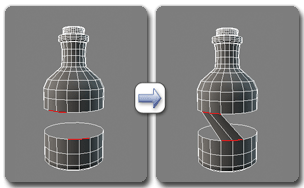
Using Bridge at the Edge level
Note: Bridge always creates a straight-line connection between edges. To make the bridge connection follow a contour, apply modeling tools as appropriate after creating the bridge. For example, bridge two edges, and then use Bend.-
 Bridge Settings Opens the
Bridge Edges caddy, which lets you add polygons between pairs of edges via interactive manipulation.
Bridge Settings Opens the
Bridge Edges caddy, which lets you add polygons between pairs of edges via interactive manipulation.
- Connect
- Creates new edges between pairs of selected edges using the current Connect Edges settings. Connect is particularly useful for creating or refining edge loops.
Note: You can connect only edges on the same polygon. Also, Connect will not let the new edges cross. For example, if you select all four edges of a four-sided polygon and then click Connect, only neighboring edges are connected, resulting in a diamond pattern.
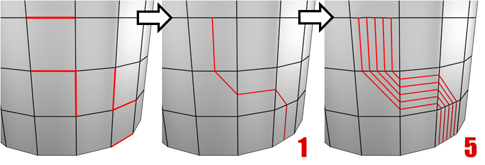
Connecting two or more edges using the Settings dialog creates equally spaced edges. The number of edges is set in the dialog. When you click the Connect button, the current dialog settings are applied to the selection.
-
 Connect Settings Opens the
Connect Edges caddy, which lets you preview the Connect results, specify the number of edge segments created by the operation, and set spacing and placement for the new edges.
Connect Settings Opens the
Connect Edges caddy, which lets you preview the Connect results, specify the number of edge segments created by the operation, and set spacing and placement for the new edges.
-
- Create Shape (From Selection)
- After selecting one or more edges, click this button to create a spline shape from the selected edges. The new shape's pivot is placed at the center of the poly object. The process varies slightly depending on the poly object type:
- With an editable poly object, a Create Shape dialog appears, letting you name the shape and set the shape type to Smooth or Linear.
- With an Edit Poly object, the shape is created immediately, using the current Create Shape settings (name and shape type).
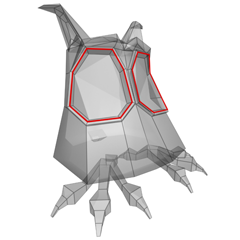
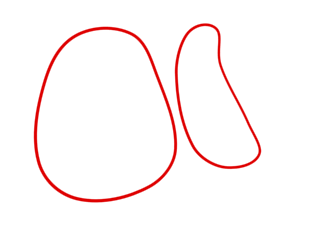
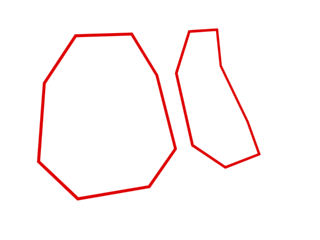
An edge selection (top); a smooth shape (center); a linear shape (bottom)
-
 Create Shape Settings (Edit Poly only)
Create Shape Settings (Edit Poly only) -
Lets you name the Create Shape output and set it to Smooth or Linear.
Edge Properties group
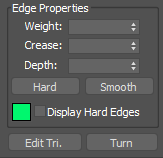
- Weight
- Sets the weight of selected edges. Used by the
NURMS subdivision option and by the
MeshSmooth modifier.
Increasing an edge weight tends to push the smoothed result away.
Note: When the Select And Manipulate tool is active at the Edge sub-object level, the caddy appears in the viewport with a control for edge weight: .
.
For instructions for using the caddy, see The Caddy Interface.
- Crease
- Specifies the extent of creasing on the selected edge or edges. Used by the
OpenSubdiv and
CreaseSet modifiers, the
NURMS subdivision option, and the
MeshSmooth modifier.
At low settings, the edge is relatively smooth. At higher settings, the crease becomes increasingly visible. At 1.0, the highest setting, the edge becomes a hard crease.
Note: When the Select And Manipulate tool is active at the Edge sub-object level, the caddy appears in the viewport with a control for edge crease: .
.
For instructions for using the caddy, see The Caddy Interface.
- Depth
- Sets the depth weight of selected edges.
- Hard
- Causes selected edges to display and render as unsmoothed. This is done by setting smoothing groups so that no two faces that adjacent to a hard edge share any smoothing groups.
Tip: This is the preferred method of using smoothing groups without having to deal with the particulars.
- Smooth
- Sets selected edges to display as smoothed by automatically sharing smoothing groups between adjacent faces.
- Display Hard Edges
- When on, all hard edges display in the viewports using the hard-edges color defined with the neighboring color swatch. For the purposes of this setting, a hard edge is the edge of a face that doesn't share any smoothing groups with adjacent faces.
Note: If the viewport is set to a shaded display mode without the Edged Faces option on, Display Hard Edges has no effect.
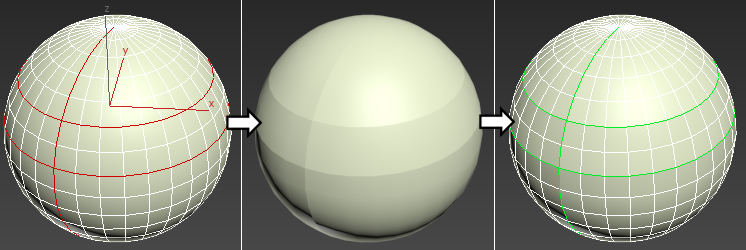
Left: edges selected; Center: set to Hard; Right: Display Hard Edges on and set to green
- Edit Tri[angulation]
- Lets you modify how polygons are subdivided into triangles by drawing internal edges, or
diagonals.

In Edit Triangulation mode, you can see the current triangulation in the viewport, and change it by clicking two vertices on the same polygon.
To edit triangulation manually, turn on this button. The hidden edges appear. Click a polygon vertex. A rubber-band line appears, attached to the cursor. Click a non-adjacent vertex to create a new triangulation for the polygon.
Tip: For easier editing of triangulation, use the Turn command instead (see following). - Turn
- Lets you modify how polygons are subdivided into triangles by clicking diagonals. When you activate Turn, the
diagonals become visible as dashed lines in wireframe and edged-faces views. In Turn mode, click a diagonal to change its position. To exit Turn mode, right-click in the viewport or click the Turn button again.
Each diagonal has only two available positions at any given time, so clicking a diagonal twice in succession simply returns it to its original position. But changing the position of a nearby diagonal can make a different alternate position available to a diagonal.
For more information on how to use Turn with the enhanced Cut tool, see this procedure.